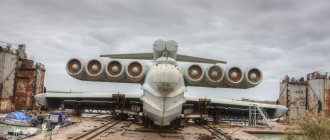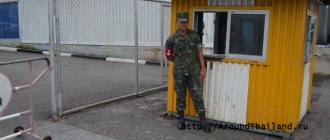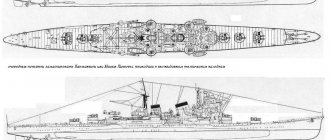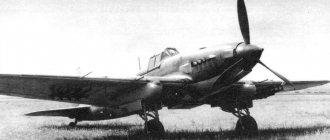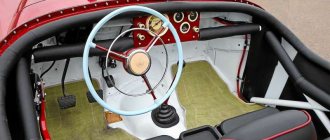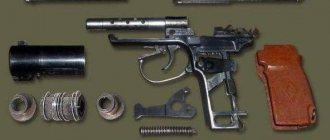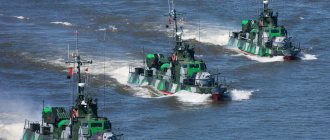The Lun ekranoplan is one of the projects of a promising type of weapon, created in the 80s in the USSR. Abroad, these machines were admired for their unusual appearance, and, without exaggeration, they were feared because of their impressive capabilities.
But due to changes in the country, they first wanted to convert this combat vehicle from a ship destroyer into a ship rescuer, and then they left it undeservedly to rust in one of the factories. This article is devoted to the history of this unique aircraft.
History of the development of ekranoplanes
At the beginning of the 20th century, during the active development of aviation, an interesting phenomenon was discovered related to the behavior of an aircraft in the air. The first pilots noticed and experienced it.
The phenomenon was as follows: when landing or when flying at low altitude over a smooth surface, the plane began to behave differently - an increase in speed and a decrease in fuel consumption was noticed. But at the same time, some force prevented the plane from landing, as if pushing it away during landing. the plane from the ground, which made landing difficult and more than once led to accidents. This phenomenon was called the “screen effect,” which later became the basis of movement for a new type of aircraft called ekranoplans.
Projects of such aircraft were developed by engineers in many countries of the world, but most of all they succeeded in the development of this type of transport in the USSR.
Since the 50s in the Soviet Union, a number of design bureaus began experiments with the screen effect, which led to the creation of prototypes of such machines. The pinnacle of the development of Soviet ekranoplanes are several types of heavy vehicles developed since the 60s, one of which was the Lun ekranoplane-missile carrier of Project 903 “Caspian Monster”.
What's next?
Despite a number of shortcomings, the flight pattern using the screen effect looks very tempting. The impressive carrying capacity of ekranoplanes makes these devices an ideal transport ship, capable of transporting people and cargo over ocean expanses.
Soviet ekranoplans were simply unlucky: a number of offensive and unnecessary accidents, a change of leadership, and the collapse of the state put an end to this potentially very interesting project. Alekseev planned not only to create huge attack and landing vehicles, but also to use ekranoplanes as a floating aircraft carrier and even a cosmodrome. This was not destined to happen.
At the beginning of this century, Boeing was engaged in a project to create a Pelican ekranoplane, which was supposed to transport 1,400 tons of cargo over a distance of up to 16 thousand km. The last mention of these works dates back to 2003.
Work is underway to create similar devices in Germany, France, China and South Korea. However, we are talking about small machines with a maximum load capacity of several tens of tons.
Small-sized ekranoplans are being developed today in Russia.
Development of ekranoplanes in the USSR
The main driver of the development of ekranoplanes in the USSR can be considered the Central Design Bureau for hydrofoils (SPK) of Rostislav Alekseev, which began work on this type of transport in the 50s. In the early 60s, this design bureau presented the first self-propelled ekranoplane models SM-1 and SM-2. They were aircraft 20 meters long, driven by a single turbojet engine and crewed by three people.
Despite a number of minor accidents, the tests of these devices were considered successful and received approval from high-ranking officials of the country. Their flight was demonstrated by D.F. Ustinov and N.S. Khrushchev, who were impressed by the tests. Perhaps thanks to this, state programs were soon approved involving the development of combat ekranoplanes, intended mainly for the navy. In 1962, the same Central Design Bureau for SPK began work on creating a heavy ekranoplane KM, and in 1964 - the T-1 project, intended for the Navy.
KM tests started in 1966. It had amazing dimensions and characteristics - length 92 m, wingspan - 37 m, take-off weight - 544 tons. The creation of the KM demonstrated all the possible development potential of these machines in the coming years - in speed it had no equal among ships and at the same time had the best carrying capacity among aircraft (before the appearance of the An-225 Mriya). The Americans were also impressed by this ekranoplan, giving it the nickname “Caspian Monster”.
The T-1 project, later called “Eaglet,” was sent for testing in 1972, and 7 years later the vehicle entered service with the USSR Navy. This ekranoplan was intended for transporting troops - it could accommodate up to 200 infantrymen or 2 armored personnel carriers. 5 such machines were built.
In addition to the landing "Eaglet", the fleet also required a combat model capable of resisting enemy ships.
It was the attack ekranoplane-missile carrier "Lun", work on which began at the Central Design Bureau in the 70s.
How does an ekranoplan fly?
The flight principle of ekranoplanes bears little resemblance to those used by conventional airplanes or hovercraft. The ekranoplan is also supported in the air by an air cushion, but it is not pumped up by special engines, but arises due to the oncoming flow.
An ordinary airplane takes off and flies because the shape and profile of its wing creates a lower pressure above its plane than below it. Not so with the ekranoplan. Due to air disturbances under its wing, it creates an area of high pressure that reaches the surface and reflects back. This is the so-called screen effect. It can only be created at very low altitudes. It depends on the shape of the wing and its extension, so the wing of an airplane and an ekranoplan are very different.
The ground effect prevents aircraft pilots from maneuvering at low altitudes, but it is the effect that forms the air cushion that keeps ekranoplanes in the air. This effect greatly interested shipbuilders: first hydrofoils appeared, and then hovercraft. However, both had maximum speed limits.
Rostislav Alekseev was engaged in the creation of hydrofoil ships for many years; his “Rockets” and “Meteors” had no analogues in the world. However, this was not enough for the designer, and in 1961 he created his first ekranoplan.
History of creation
The design assignment for the development of the ekranoplane-missile carrier "Lun" was issued in 1970 by the Central Design Bureau for the SPK. V.N. was appointed chief designer. Kirillov. The task involved the creation of a heavy ekranoplan weighing more than 200 tons, capable of carrying ZM-80 Moskit anti-ship missiles.
By 1980, technical documentation was ready and the development of working drawings began. During development, the designers actively used the results of previous developments on KM and Orlyonok; in particular, many on-board systems and control systems were borrowed, which significantly reduced the design time. In 1983, construction of the first model began, and already in 1986 the Lun ekranoplane was put into operation. Tests began in 1987, and trial operation of the missile carrier began in 1990.
Vladimir Nikolaevich Kirillov was born on March 30, 1931 in the village of Verkhoshizhemo. From his youth he was fond of yachting; at the yacht club he first met Rostislav Alekseev. Graduated from the shipbuilding department of Nizhny Novgorod University. In 1960, he began working at the Central Design Bureau for the SPK, was successively promoted, and in 1976 was appointed chief designer for the 903 Lun project. Kirillov considered ekranoplanes to be an advanced weapon that gave a great advantage in the arms race.
Vladimir Nikolayevich had high hopes for the Lun under construction and positioned it as a universal weapon against any enemy surface forces that existed at that time.
Plans
The missile carrier is the main exhibit of the Patriot park under construction, which is promised to open in 2023. Various events will be held in the Military History Park: open history lessons, Youth Army rallies and other youth congresses. Despite the construction work around, the military apparatus has already become one of the main attractions of the city; people come from different cities of Russia to take photos of the Lun ekranoplane in Dagestan.
You can visit the attraction at any time; the operating hours of the Lun missile carrier are not set. Be sure to take a photo as a souvenir; you won’t be able to see a similar device anywhere else.
Screen effect phenomenon
To begin with, it is worth telling how ekranoplanes carry out their flight, and what difficulties are associated with this. Delving into the essence of the phenomenon, one can notice that humanity observed the screen effect long before the advent of airplanes - it was used by some species of birds.
For example, seagulls, flying over the surface of the water, deliberately descended to the very surface of the water and continued their flight like that. At the same time, it was noticeable that the seagulls began to flap their wings much less often during such a flight. Thus, birds use the screen effect to facilitate flight and save energy. But how does this effect help them?
Let's understand the essence of this phenomenon.
It is based on the difference in pressure above the wings (of an airplane or bird) and below them. In simple terms, the change in pressure occurs like this: during horizontal flight, the oncoming air flow seems to hit the surface of the wing and some part of it goes down, under the wing itself.
When flying at altitude, this would have virtually no effect, but when moving low over a smooth surface (ground, water, ice), the flow of air that went down shields it from the surface and returns back, as if pushing the wing from below, thereby increasing the lifting force , which is what the birds used when flying.
The effectiveness of the screen effect depends on the following parameters:
- wing width (the larger it is, the greater the flow the wing will support, and the greater the effect);
- altitude and flight speed (the lower the flight and the lower the speed, the more efficient the flight).
But in the seeming simplicity of using this effect, which even birds have mastered, there are also difficulties. This is due to balancing and maneuvering when flying above the screen - even with a slight change in altitude or speed, the center of pressure of the screen effect also changes, which changes the balance of the aircraft and can create an unexpected roll. Because of this, the same seagulls, if they are going to change direction or dive for fish, first rise up from the water so that the screen effect does not cause inconvenience when maneuvering.
WIG design
Externally, the Lun resembles a large transport aircraft - a long and wide fuselage, wings with a large span, and a large tail. But there are quite a few differences from the aircraft layout. "Lun" has a hull 73 m long and 19 m high.
The fuselage consists of panels made of aluminum-magnesium alloy, up to 12 mm thick.
The bottom of the hull, like ships, has a paint coating and electrochemical protection against corrosion. A few more “marine” features of the Lunya: the lower part of the hull is covered with fairings, and there is also a hydroski on the bottom, designed to soften landing on the water.
In the front of the hull there is a pylon on which 8 traction motors are located. Their nozzles are installed at an angle to the water, due to which the flow they force goes into the water and screens it from it into the wings located slightly behind, due to which in this case the screen effect is achieved. The wings have a trapezoidal shape, their span is 44 m, their area is 550 m2, they also have flaps divided into 12 parts. The stabilizer is all-metal, its area is 227 m2. Its end is made of foam plastic lined with fiberglass.
The fuselage of the ekranoplan is equipped with weapons - three pairs of ZM-80 Moskit anti-ship missiles. Under the front pair there is a cabin of gunners-operators, in which there are GSh-23 aircraft cannons. Behind the installations there are thermal protection sheets to protect the body from high temperatures when launching missiles. Another gunner's cabin with a cannon mount is located at the rear of the hull.
You can get inside the Lunya in two ways - through the doors on the sides of the hull or through the hatch on the roof. The internal compartments are divided into 4 groups: bow, central, stern and keel compartments. In the bow there is a cockpit and rooms with auxiliary power units.
The central part houses numerous equipment of the ekranoplan, as well as cabins and accommodations for the crew.
The aft section is occupied by various equipment, in the keel area there is an installation for supplying the ekranoplan with electricity, as well as radio equipment and navigation aids, and the gunner’s cabin is located in the upper part of the keel.
Interesting Facts
- Several Lun missile carriers are present in the computer game World in Conflict: Soviet Assault. However, unlike reality, in the game the ships have a landing compartment[22]. One ekranoplane of the "Lun" type is involved in the plot of the game James Bond 007: Blood Stone[23][ unauthorized source?
2041 days ]. - The ekranoplan was nicknamed the “aircraft carrier killer” for its specialization in the destruction of these ships[6].
- The Lun ekranoplan is one of the largest aircraft ever produced[5].
- The ekranoplan "Lun" is present in the anime Aldnoah.Zero (second season, first episode).
- The ekranoplane "Lun" is present in the first chapter of the visual novel "2032" - from its board a small nuclear weapon is launched that destroys an artificial island in the Caspian Sea on which the shelter of the supercomputer "Ganymede" is located.
Specifications
The Lun is powered by eight NK-87 aviation turbojet engines, developed on the basis of the turbines of the Il-86 aircraft. They have a take-off thrust of 13,000 kgf, and with these engines, the Lun is capable of accelerating to 500 km/h, and its cruising range is 2,000 km. The empty weight of the vehicle is 243 tons, and the maximum take-off is 380 tons. The crew consists of 10 people.
The main flight altitude of an ekranoplan is up to 10 m, but it can also fly outside the screen at an altitude of up to 500 m. In practice, according to pilots, in this flight mode the machine became unstable and did not obey the rudders, so it was planned to tear away from the screen only in emergencies cases.
Like all ekranoplanes, in screen mode the Lun can fly not only over water, but also over any flat surface - for example, over ice or over the ground. But unlike the landing "Eaglet", the "Lun" does not have a landing gear, it only has a hydroski, because of this it can only land on water. And therefore, a special floating dock was used to base it on land.
But thanks to the hydroski, the “Lun” could be operated in high water waves – up to 5-6 points, versus 3-4 for the “Eaglet”.
Let's take a closer look at the ekranoplan's armament. It consists of six ZM-80 Moskit supersonic low-altitude anti-ship missiles. They are intended to destroy surface ships with a displacement of up to 20 thousand tons. The missile engagement range is from 10 to 250 km.
Characteristics of the Moskit anti-ship missile system:
- Rocket flight altitude: 7-20 m.
- Launch height: 20 m.
- Launch range: up to 250 km.
- Maximum flight speed of the rocket: M=2.8.
- Rate of fire during salvo launch: 5 sec.
It was believed that four such missiles would be enough to destroy any potential enemy ship, including an aircraft carrier. Also, one of the advantages of the Lun is the ability to launch these missiles on the move. In addition to missiles, the ekranoplane has auxiliary weapons - two installations with twin 23-mm 2-barrel GSh-23 aircraft cannons, which are located in the bow and stern.
Another important characteristic of the vehicle is its stealth to radar. In general, it is inherent in almost all ekranoplanes and lies in the fact that their flight altitude is too low for aircraft radars to detect them. They also remain invisible to sea locators, since they do not touch the water surface during flight.
According to the stories of test pilots, during tests in the Caspian Sea they flew near the location of the missile battalion against low-flying targets, and they really could not detect the ekranoplan on radar, although they saw it visually.
Cruise missile 3M-80 Moskit
A powerful supersonic missile with a ramjet propulsion engine, with a successful hit, was capable of sending any NATO warship to the bottom. From the beginning of the eighties, the newest destroyers began to be equipped with it, and at the same time the Lun was also equipped. In principle, its main purpose was “to destroy carrier-based multipurpose or strike groups of the enemy Navy in cooperation with other naval forces.” It is significant that US military experts dubbed it the “Aircraft Carrier Killer.”
Launchers of the 3M-80 cruise missile
The 3M-80 cruise missile is part of missile systems that are designed to destroy surface ships and transports from naval strike groups, landing formations and convoys, both displacement and hydrofoil and air-cushioned, with a speed of up to 100 knots, in conditions of enemy fire and electronic countermeasures, in any environmental conditions, when exposed to the damaging factors of a nuclear explosion. In the early 80s, the 3M-80 Moskit anti-ship complex was adopted by Project 956 Sovremenny class destroyers. These ships were equipped with two quadruple KT-190 launchers.
6 anti-ship missile launchers ZM-80 Moskit installed on Lun
The first destroyer of Project 956 “Modern” (serial number 861) was laid down at the plant named after. Zhdanov (now "Northern Shipyard") in Leningrad on March 3, 1976, launched on November 18, 1978, and on January 24, 1981 included in the Northern Fleet. The second destroyer “Desperate” was laid down on March 4, 1977, launched on March 29, 1980, and commissioned into the Northern Fleet on November 24, 1982. In total, by the end of 1993, 17 Project 956 ships were built at Severnaya Verf, and several more remained unfinished due to the collapse of the USSR. Two of the unfinished destroyers of Project 956 - “Vazhny” and “Thoughtful” (renamed “Ekaterinburg” and “Alexander Nevsky”) were sold to the PRC along with the Moskit complex due to lack of funding.
Cruise missile 3M-80
Since the early 1980s, the possibility of installing the Moskit complex on the Lun ekranoplane of Project 963 was considered. For this, a mock-up of the ekranoplane of Project 903 was installed at the Peschanaya Balka training ground in the village of Chernomorsk. The main purpose of the tests was to test the ability of the ekranoplane design to withstand force and thermal effect of the starting engine jet. On October 5 and December 21, 1984, two launches of Mosquito prototypes, equipped only with starting engines, were carried out. The first launch was made from the right container of the forward pair of launchers, and the second launch was made from the left container of the tail pair of launchers. Since there were only two containers, during the first launch the bow pair stood in its place, and then it was moved to the tail.
During these tests, two options for loading missiles onto the ekranoplane were tested: in the first option, the rocket was loaded into a container already installed on the ekranoplane using a loading device; in the second version, the rocket was loaded into a container located on the ground, and then the entire structure was installed on an ekranoplane. All launches went well. After the first launch, 9 tiles were damaged, after the second - 2. Two launches of ZM-80 missiles were carried out in the Caspian Sea. The target was BKShch pr. 436bis. The first launch was unsuccessful due to crew errors. During the second launch, a two-missile salvo was fired (with an interval of 5 s). The launch was considered successful
Comparison with analogues
Speaking about the issue of comparing the Lun with analogues, there is no one to compare it with - no one except the USSR produced heavy ekranoplanes, and in terms of its purpose, the Lun can generally be called the only combat ekranoplan in the world (the Soviet KM and Orlyonok were rather transport).
| "Lun" | BoeingPelican | KM | |
| Length, m | 73 | 122 | 92 |
| Maximum speed, km/h | 500 | 720 | 500 |
| Cruising speed, km/h | n/a | 460 | 430 |
| Travel range, km | 2000 | 18520 | 1500 |
| Wingspan, m | 44 | 152 | 37 |
| Load capacity, t | 140 | 1200 | 304 |
But let’s take a look at the characteristics of the “Lun” in comparison with its “progenitor” - the KM ekranoplan. Let’s also compare it with the Boeing Pelican, an American cargo ekranoplane developed by Boeing since the late 90s, but which was never built even in prototype form. In comparison with the KM "Lun" it wins in range and smaller size, but loses in carrying capacity, since it was not originally conceived as a transport vehicle.
But in comparison with the Boeing Pelican, even the monstrous KM pales. The Pelican's carrying capacity was supposed to be more than 1,000 tons, and its cargo compartment was supposed to accommodate up to 17 Abrams tanks (despite the fact that US transport aircraft can only take one tank on board). The estimated size of the American is also striking, its wingspan is 3 times greater than that of the Lun.
Abroad
The most high-profile foreign project was the Boeing Pelican, a military ekranoplan with the ability to transport 1,200 tons at a time. He did not go further with development; the concept turned out to be too huge and hardly feasible even by the standards of the American military, which does not particularly consider money.
The device was supposed to fly at an altitude of about ten meters above the sea, with the ability to rise to a height of 6000 meters for flights over land or to avoid storms. At one time, the Pelican could lift up to 17 M1 Abrams tanks or almost 200 20-foot shipping containers. However, nothing has been heard about this project since 2013.
There was information about the construction of a large ekranoplan by South Korea, however, this project is currently frozen.
Advantages, disadvantages and possible applications
Let us once again list all the advantages of ekranoplanes in comparison with other types of transport:
- High speed combined with high load capacity.
- The ability to fly over land and ice, the ability to fly at high altitudes.
- High survivability - in the event of engine failure, the ekranoplan can fly on the remaining serviceable ones or land on the water for repairs.
- Stealth to radar.
- The ability to quickly take off without the need for a runway.
But these devices also have disadvantages. One of them is a consequence of the screen effect, due to which the center of gravity of the ekranoplan changes during maneuvering. This makes their maneuverability low, and their control specific, requiring special training. It can also be noted that the large dimensions of these vehicles make them more vulnerable to enemy fire.
The Lun ekranoplans were planned to be used as a means of destroying enemy ships, in particular aircraft carriers. Due to their speed and stealth, they could approach the target within missile launching distance, and then quickly leave.
Notes
- ↑ 123456789
Apalkov, 2004, p. 28. - ↑ 12345
[izvestia.ru/news/507349 The Ministry of Defense has finally abandoned ekranoplanes] - ↑ 123
Kachuk, 2007. - “Lun” is the code for Project 903, and not the name of the only ekranoplan rocket created. However, for convenience and brevity, in the article the ekranoplan rocket ship will be called “Lun”.
- ↑ 12
[www.globalaircraft.org/planes/lun_ekranoplan.pl Lun Ekranoplan] - ↑ 12
[www.utro.ru/articles/2012/09/11/1070939.shtml They are trying to bring the secret weapon of the USSR back to life] - In the journal “Science and Technology” and in the books “Winged Ships of the Fatherland” and “Seaplanes and Electric Planes of Russia”, the year of testing began is 1985. In an article in the journal “Technology and Armament”, July 16, 1986 is designated as the first launching.
- [vz.ru/economy/2011/8/12/514212.html Potential demand is high]
- Gorshkov, S. G. Sea power of the state. M., Voenizdat, 1972.
- Lun (ekranoplan)#Comparison with analogues
- [www.newsru.com/russia/02sep2012/ekranoplan.html In Russia they are reviving the idea of “Caspian monsters” - giant ekranoplanes that frightened NATO]
- [nn.mk.ru/article/2011/12/29/657953-ubiytsu-avianostsev-pod-bolgarku.html Aircraft carrier killer - under the “grinder”?]
- [www.aif-nn.ru/society/details/534054 The Lun ekranoplan will be returned to Nizhny Novgorod residents]
- [imhonn.ru/peticii/7 Let's save the attack ekranoplan-missile carrier "Lun"]
- [www.aif-nn.ru/society/details/540322 Returning the missile carrier “Lun” to Nizhny is too expensive]
- [www.nn.ru/info/news/zachem_nizhnemu_novgorodu_tratit_milliony_na_nedostroennyy_ekranoplan_d.html Why would Nizhny Novgorod spend millions on an unfinished ekranoplan for Victory Park?]
- [nn.mk.ru/article/2012/04/19/695127-u-lunya-shansov-malo.html “Lunya” has little chance]
- [nn.mk.ru/article/2013/03/13/825437-ekranoplanu-podyiskivayut-mesto.html They are looking for a place for the ekranoplan]
- [www.airwar.ru/enc/bomber/tu95.html Flight characteristics of the Tu-95]
- [www.airforce.ru/aircraft/tupolev/tu-160/book/page_2_6.htm CHARACTERISTICS OF THE TU-160 BOMBER]
- Ilyin V. E., Levin M. A. Bombers.-M.: Victoria, AST. 1996.-272 p. Volume 1. p. 68 ISBN 5-89327-004-5
- [ss-op.ru/reviews/view/37 WIG harrier project 903 by Rostislav Alekseev. The world's first ekranoplane-rocket carrier]
- [ru-klukva-ru.livejournal.com/745885.html Bond, James Bond]
Further fate
The changes of the late 80s had a negative impact on the development program of such transport in the USSR. Work on the machines under construction stopped, and those already in use were taken out of service. But in 1989, the prospect of building an ekranoplane for civilian purposes arose - they decided to convert the second Lun, which was under construction, into a search and rescue vessel for ships in distress.
In this regard, the rocket launchers were removed from the ekranoplan, which increased its carrying capacity and maximum speed, and the compartments freed from equipment were supposed to serve to accommodate up to 500 rescued sailors. This ekranoplan was named “Rescuer”.
But the final collapse of the country put an end to this project as well. The new government had no time for promising military projects, and the practical need for the “Rescuer” had disappeared - most of the fleet had been sold or taken out of service, and the Navy no longer had any special need for a rescue ship.
Thus, the almost completed “Rescuer” has been forgotten for many years on Nizhny Novgorod, rusting in the dock in the city of Kaspiysk. The question of disposing of ekranoplanes and creating museum exhibits from them has been raised several times, but nothing is known about the solution to these issues.
Literature
- Petrov G. F.
Seaplanes and ekranoplanes of Russia. 1910-1999. - M: RUSAVIA, 2000. - P. 206,207. — 248 p. — 3000 copies. — ISBN 5-900078-05-1.
- Apalkov V. A.
2 // Small rocket ships and boats. - St. Petersburg: Galeya Print, 2004. - T. 2. - P. 25 - 28. - 122 p. — (Ships of the USSR Navy. Handbook in four volumes). — ISBN 5-8172-0087-2.
- Yablonsky P. P.
Winged ships of the fatherland. - M, 1997. - T. 98. - P. 44 - 49. - 122 p. — ISBN 5-093-85941 (erroneous).
- Pavel Kachur
Part IV. Ships flying over the waves // Equipment and weapons: magazine. - M., 2007. - Issue. 05.
- Efimenko Yaroslav, Skulin Andrey
Ekranoplans. Part 2 // Science and technology: magazine. - M., 2009. - Issue. 08. - pp. 28,29.
Mark on history
A family of Soviet heavy ekranoplanes developed at the Central Design Bureau of the SPK named after R.E. Alekseev, demonstrated to the world the unique capabilities of this type of transport. But in the modern world there is no place for ekranoplanes yet.
In Russia, after the final closure of the “Rescuer” project, many developments on ekranoplanes were abandoned and specialists in working with them were lost.
So the revival of the production of heavy ekranoplanes in Russia is unlikely and is associated with great difficulties.
In the rest of the world they are also not remembered yet. In the 1990s, the United States planned to build cargo ekranoplanes - in particular, Boeing planned to build a Pelican ekranoplane with a lifting capacity of 1,200 tons by 2015, which could be used for both civilian and military purposes.
But in the end, studies showed that these projects would be unprofitable. Although ekranoplanes have an advantage in efficiency and carrying capacity over airplanes, significant savings in transportation will be achieved only when building heavy vehicles, which in turn is associated with difficulties and high costs for mastering production. Perhaps this is one of the dead-end branches of aviation development. But this will most likely be judged only in the next century.
Where is the Lun ekranoplan located?
After the closure of Project 903, within which it was planned to build eight such machines, the Lun turned out to be the only fully modified and put into operation model. After decommissioning, the ship remained for many years in Kaspiysk, on the territory of the machine-building plant. Outsiders were not allowed into the enterprise, which made it possible to preserve the unique development from destruction and looting.
Now the Lun ekranoplane has been moved to Derbent. A giant car, as tall as a five-story building, is stranded on a wild beach. It is planned that it will remain on the shores of the Caspian Sea until the summer of 2021, then the missile carrier will begin to be moved to the Patriot military-patriotic park, where it will become the central exhibit. Construction of the park in Derbent is expected to be completed by 2023.
© Julia Alisova
